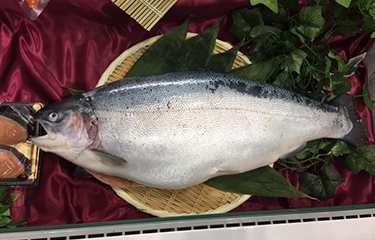The 24th Japan International Seafood Show, held from 24 to 26 August in Tokyo, highlighted how trout – which the Japanese generally include in the salmon category as “salmon-trout” – is gaining popularity domestically.
Salmon is perenially the top sushi topping in Japan, and salmon producers were prominent at the latest edition of the seafood show, where Chile-based Caleta Bay showcased its coho salmon and steelhead trout, Scotland and Norway had pavilions featuring Atlantic salmon, and Tasmania, Australia-based Huon showcased its Atlantic salmon via distributor Blue Link, which is based in Hamamatsu, Shizuoka Prefecture, Japan.
Japan's imports of trout have been buoyed by salmon’s popularity, attrating a wide variety of suppliers to the show. Turkey-based fish feed, aquaculture, and exporting company Gumusdoga Seafood made an appearance, as the company has seen its sales to Japan rise, according to Oguz Kileci, the company's director of international sales.
“We have been selling to Japan and increasing year by year,” he said.
Japanese customs data for 2019 showed Turkey was ranked third in volumes of frozen trout exported to Japan. Chile led with 9,048 metric tons (MT), followed by Norway with 1,902 MT, and Turkey with 547 MT. In the same year, imports of fresh trout were much smaller, led by Norway with 738 MT and followed by Chile with 369 MT.
Turkish export specialist Kent Forum Fuercilik reported the country’s total aquaculture exports of trout in 2021 were valued at JPY 19.6 billion (USD 143 million, EUR 143.4 million), up 19 percent from JPY 16.5 billion (USD 120 million, EUR 120.4 million) in 2020.
A key market for Turkish aquaculture, however, will continue to be Russia. Aquaculture exports to Russia topped USD 217 million (EUR 217.7 million) in 2021. This includes sea bream, salmon – really rainbow trout branded as Turkish salmon – tuna, and sea bass. This year, the figure is likely to be higher, since Turkish aquaculture has benefitted from Europe’s commercial break with Russia.
“Nobody is selling to Russia except us,” Kileci said.
Another attendee of the event was Japan-based Okumura Foods, which imports salmon from Norway and Chile and also sends it to Vietnam for contracted processing. The company sells vacuum-packed Aquaculture Stewardship Council-certified fish to supermarket chains, including Aeon, though it also produces and sells some non-certified items. It also owns Musholm, a salmon-farming subsidiary in Denmark.
In 2015, Okumura Foods started domestic production of Donaldson trout in Aomori Prefecture via its subsidiary Japan Salmon Farm Co., and the company has branded its products “Aomori Salmon.” In 2019, it acquired Aquaculture Stewardship Council certification for all of its Japan Salmon Farm-branded salmon. The company has dual head offices in Aomori – where the company’s production and processing is done – and in Tokyo, where the company's sales office is based.
In Japan Salmon Farm's Aomori farming operation, the trout spend time in land-based raceways before being stocked to ocean pens. Amanda Chao, who works in the company's Tokyo office, said the company expects its production to be down by about a quarter due to torrential rains.
“There were landslides and flooding and the water became muddy, so the fish couldn’t breathe," Chao said.
A second domestic producer, Yamanashi Aquaculture Fisheries Cooperative, is farming a chinook salmon and rainbow trout hybrid. The hybrid, branded as “Fujinosuke" in reference to Mt. Fuji, is a cross of male chinook salmon and female rainbow trout originally developed by Yamanashi Fisheries Technology Center and the Yamanashi Aquaculture Fisheries Cooperative.
Ryo Ogawa, who heads the Yamanashi Prefecture Agricultural Administration Department's domestic sales support team, said beyond good feed conversion and faster growth, the hybrid has a better taste than ordinary rainbow trout.
“It is raised entirely in fresh water,” Ogawa said.
The company promotes its fish in printed materials saying "it combines the deliciousness of king salmon with the ease of raising rainbow trout," and by advertising it as lower in calories and higher in protein than Atlantic salmon or rainbow trout. Testing with a sensor found it is also saltier and has a more umami taste than Atlantic salmon or rainbow trout, according to the company.
In addition to Fujinosuke, the company is also promoting two other original products: Kai Salmon, which is a large rainbow trout, and Kai Red Salmon, which is rainbow trout raised on feed containing powdered wine residue. And it grows and sells three indigenous salmonids: the yamane (masu salmon, or Oncorhynchus masou); iwana (white-spotted char, or Salvelinus leucomaenis); and amago (red-spotted masu salmon, or Oncorhynchus masou macrostomus).
Photo by Chris Loew/SeafoodSource







